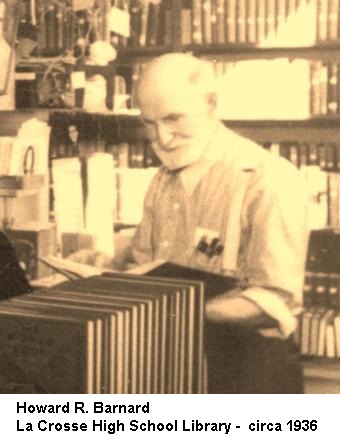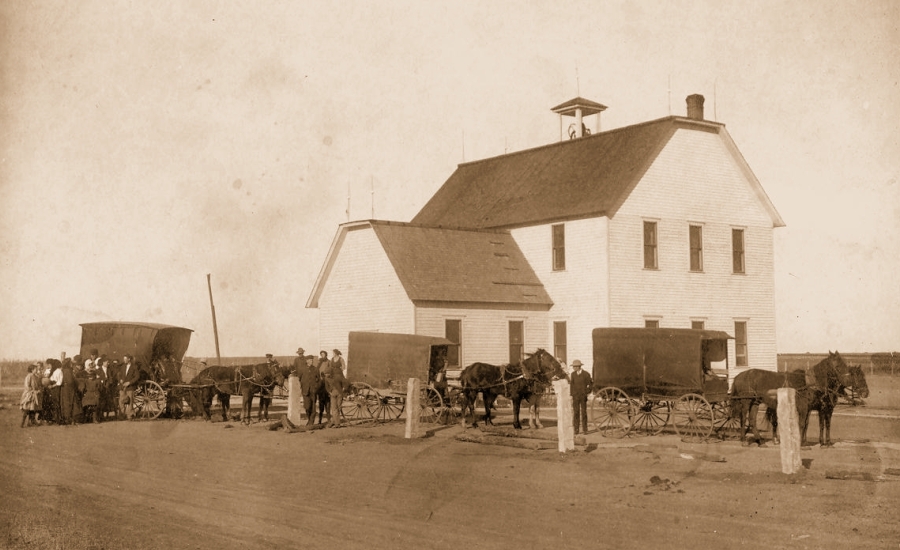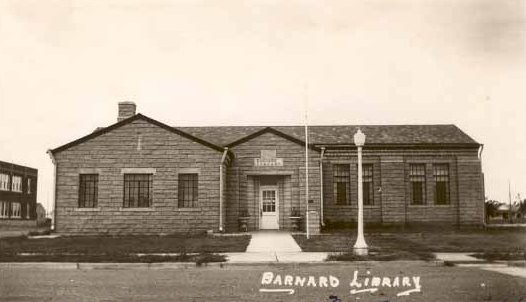Pleasant Point School

Howard Barnard - Pioneer Educator
 Howard Barnard’s great-uncle Henry Barnard (1811-1900), a Yale graduate, and Horace Mann started the Common School Movement of 1820-1860 to bring uniformity to all schools in the country.
He also worked to establish “Normal Schools” to provide teacher training which, at the time, was a rare opportunity for women to receive a college-level education.
Howard Barnard’s great-uncle Henry Barnard (1811-1900), a Yale graduate, and Horace Mann started the Common School Movement of 1820-1860 to bring uniformity to all schools in the country.
He also worked to establish “Normal Schools” to provide teacher training which, at the time, was a rare opportunity for women to receive a college-level education.
Frederick Barnard (1808-1889), also a relative of Howard and a Yale graduate, became president of Columbia University in 1864 and while there founded Barnard College, a branch of Columbia University for women.
An exhibit at the Philidelphia Centennial Exposition in 1876 convinced young Howard Barnard to eventually move to Kansas. In 1881, at the age of 18, against the urging of his family to remain in New York and continue his education and with no money, he headed west. He made the majority of the trip on foot, stopping to do odd jobs to earn money to continue his journey. Three years later, in 1884, he reached the Missouri-Kansas border and boarded an Atchinson, Topeka, & Santa Fe train to Great Bend. From there, he walked 30 miles to Rush Center, where he worked odd jobs and became a teacher's aid. In 1885, he went back to New York returning to Rush County the next year bringing with him a collection of books.
While working on a ranch in the McCracken area, he started an open-air school with “the sky as the roof and tufts of buffalo grass as the seats.” A blizzard in 1886 wiped out the rancher's cattle and Howard was forced to give up his school for the time being. It was also during the blizzard that, while attempting to rescue some of the cattle, he froze his feet so severly that he wore heavy felt boots winter and summer for the rest of his life.
In 1888, Barnard passed the county teachers' exam and taught at a number of one-room schools in the McCracken area. During this time he wrote an educational column for the “McCracken Enterprise” and started the McCracken Teachers Association. Using his own money, he built additions and made improvements to some of the schools where he taught.
Entre Nous College
(The following are excerpts from “Rush County - 125 Years in Story & Pictures”)
 “After fifteen years of teaching in 1905, Howard received $16,000 from his father’s estate and he put it all into making his dream for education
on the prairie come true. He bought four acres of land from Abram Haas on a corner opposite Locust Grove School and later added six acres to it.
The site was eighteen miles northwest of LaCrosse and four miles northeast of McCracken. He built there according to his own specifications one of the
most unusual schools in Kansas. It was called Entre Nous (among us) College and was a forerunner of the consolidated school. The building was a large,
two-story, white frame structure that contained an auditorium, a central heating plant, a grand piano, and wonder of wonders, a telephone. There were an athletic field,
bleachers for 300 spectators, and gasoline lamps imported from the east.
“After fifteen years of teaching in 1905, Howard received $16,000 from his father’s estate and he put it all into making his dream for education
on the prairie come true. He bought four acres of land from Abram Haas on a corner opposite Locust Grove School and later added six acres to it.
The site was eighteen miles northwest of LaCrosse and four miles northeast of McCracken. He built there according to his own specifications one of the
most unusual schools in Kansas. It was called Entre Nous (among us) College and was a forerunner of the consolidated school. The building was a large,
two-story, white frame structure that contained an auditorium, a central heating plant, a grand piano, and wonder of wonders, a telephone. There were an athletic field,
bleachers for 300 spectators, and gasoline lamps imported from the east.
Only one pupil, a high school girl, showed up the first year, but the next year there were ten high school students and sixty grade school students. Entre Nous became the social center for the surrounding area. Mr. Barnard started the first “bloomer girl” basketball team and he paid for all of the athletic uniforms and equipment. He had six horse-drawn wagons that served as buses to bring the students to school and home again. For eight years, the country youth of Rush County lived in educational clover. They took full advantage of an excellent modern school, a faculty of unusual ability, a well-filled library and the mental and physical freedom that suddenly had become theirs.
Then suddenly Entre Nous School was forced to close its doors. A quarrel among the heirs to Mr. Barnard’s father’s estate tied up his funds from 1912 on. Lawyers promised a renewal of the income but that never happened. The courageous and generous teacher made every effort to keep the school but to no avail. A mortgage company moved the buildings to nearby towns and divided them into smaller units that were put to use as dwellings and stores.”
“Ralph Plotner, who both graduated from, and taught at, Entre Nous College, reported that the following courses were provided there in the four years of his high school education: Freshman Courses: English Composition, Ancient History, Elementary Algebra and Beginner’s Latin; Sophomore Courses: English Literature, Modern & Medieval History, Plane Geometry, Caesar’s Gallic Wars; Junior Courses: Rhetoric, Shakespeare, English History, Solid Geometry, Orations of Cicero; Senior Courses: Rhetoric, Shakespeare, American History, Constitution, Commercial Arithmetic, Bookkeeping, Virgil’s Aeneid.”
The Barnard Library
 After Entre Nous closed Barnard again turned to teaching. With a passion for books, he began to accumulate a massive private library. Often, after completing the day teaching, Barnard would walk 25 miles north to Hays to buy books, returning the next morning in time to resume classes.
Barnard was a rigid disciplinarian, but kind and considerate to his pupils. He had little patience with county superintendents who often did not have the same level of education as he did. When superintendents tried to have him fired, mothers of the students intervened.
In 1916, he was invited to move his collection of over 3000 books to the newly-constructed La Crosse High School. Later that year, the superintendent succeeded in firing him because his found his strict library rules to be overbearing. Learning about this and discovering that Barnard was
destitute and sleeping in the railroad depot, several women in the La Crosse area banded together, formed the Barnard Library Association and raised money for his living expenses. They also got him reinstated as High School librarian paying his salary through the association. Within a year,
he quit the High School and began teaching in rural schools in the area. At the 1923 annual meeting of the district, citizens demanded the school board rehire Barnard. He and his books remained there until 1937.
After Entre Nous closed Barnard again turned to teaching. With a passion for books, he began to accumulate a massive private library. Often, after completing the day teaching, Barnard would walk 25 miles north to Hays to buy books, returning the next morning in time to resume classes.
Barnard was a rigid disciplinarian, but kind and considerate to his pupils. He had little patience with county superintendents who often did not have the same level of education as he did. When superintendents tried to have him fired, mothers of the students intervened.
In 1916, he was invited to move his collection of over 3000 books to the newly-constructed La Crosse High School. Later that year, the superintendent succeeded in firing him because his found his strict library rules to be overbearing. Learning about this and discovering that Barnard was
destitute and sleeping in the railroad depot, several women in the La Crosse area banded together, formed the Barnard Library Association and raised money for his living expenses. They also got him reinstated as High School librarian paying his salary through the association. Within a year,
he quit the High School and began teaching in rural schools in the area. At the 1923 annual meeting of the district, citizens demanded the school board rehire Barnard. He and his books remained there until 1937.
In 1937, through the Works Progress Administration, the township constructed a new stone library naming it Barnard Library in his honor. On dedication day, the town held a large parade in his honor and all of the schools closed. While many of his former students cheered, Mr. Barnard shyly expressed his gratitude. There Barnard served as librarian until his death in 1948.
Barnard had great respect for his library. Every night as he closed the library, he lifted his hat and said goodnight to the building and his books. He was quoted as saying, “At my age one never knows what may happen before morning and I wouldn’t want to leave before saying good-bye.”